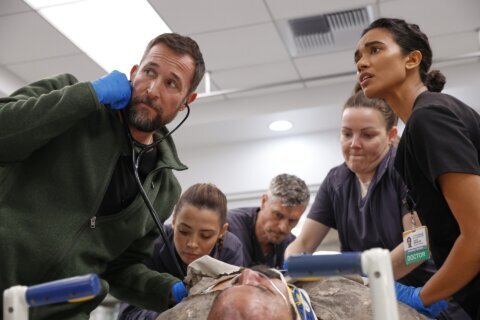This video is no longer available.
Hear our full chat on my podcast “Beyond the Fame with Jason Fraley.”
He went from Olympic gold to WWE champion, battling addiction and coming out clean on the other side.
If a Hollywood screenwriter wrote Kurt Angle’s life as a fiction movie script, no one would believe it, and yet here it is chronicled in the new sports documentary “Angle,” directed by Alex Perry and now streaming on Peacock.
“It was time for me to tell my story,” Angle told WTOP. “I thought the director did an incredible job. It’s a great documentary put together very well. It’s about a kid with a dream, he had a few mishaps along the way, but he was able to make his dream come true and ends up going into a business that he never thought he would do, the WWE, where I had just as good of a career as my amateur wrestling career, but there were a lot of demons I had to face.”
Born in Pittsburgh in 1968, Angle was just 16 years old when his father was killed in a construction accident, but he dug down deep to win the Pennsylvania state wrestling title at Mt. Lebanon High School and become a two-time NCAA Division I national champion at Clarion University of Pennsylvania. While training for the Olympics at the Foxcatcher Club, his beloved mentor, Dave Schultz, was tragically murdered by coach John du Pont in 1996.
“It motivated me to become better,” Angle said. “My father was my biggest fan growing up, he never missed any of my sporting events. … He just wanted me to give my best. The only times he would ride me is if I didn’t give my best. … My coach Dave Schultz was the same way. Dave was incredible. He learned seven languages from different countries just so he could learn the sport of wrestling worldwide and he became the best technician in the world.”
That work ethic inspired him to train harder than anyone for the 1996 Summer Olympics in Atlanta, running the steep hills of Pittsburgh while carrying people on his back. He kept a regimented calendar of what he calls “exhaust training” to build up maximum stamina to win the Olympic gold medal with a “broken freakin’ neck.”
“That’s when you train until you’re exhausted — and that’s when it actually begins, so you go beyond your limitations,” Angle said. “I wasn’t the biggest, fastest, strongest or most technical, but I knew I could wear my opponents down and get them tired. It’s crazy because people give up when they get tired. They said, ‘I’m tired, I can’t go anymore,’ and from a mental standpoint, I knew the breaking point of my opponent every time I wrestled.”
After achieving his lifelong dream of winning an Olympic gold medal, he didn’t know what to do next.
“That’s all I ever dreamed about since I was a kid,” Angle said. “The next day you wake up and you’re like, ‘What do I do now? What the heck can I do now to match what I just did?’ … I did broadcasting for a year, it was horrible, I was so bad! … I’m the weekend sports anchor and the first thing that happens is I run into the producer and my scripts fly into the air all out of order. My producer says, ‘Just read the teleprompter!’ and the teleprompter goes blank.”
Around that time, he turned down Vince McMahon’s offer to join the WWF, now WWE.
“Vince offered me a multimillion-dollar contract and my agent said, ‘You’re not gonna do this crap, you’re the real deal, they’re fake,'” Angle said. “I started watching the WWE, because I’d never watched. … I’m like, man, these guys are good athletes and these storylines are hilarious! Best era of wrestling: DX, Stone Cold, all that, so I called WWE in 1998, talked to Jim Ross and I said, ‘Hey, does that contract still stand?’ He said, ‘No, you have to try out.'”
After his first tryout, he accepted a WWE contract of $75,000 a year, which didn’t last long after paying for travel, lodging and food expenses on the road every week, but he realized the potential upside if he stuck it out. However, he was initially surprised that McMahon wanted him to portray a heel as a cocky but corny Olympic hero villain.
“He sat me down and said, ‘Listen, we’re going to make your character the man with the ‘Three I’s: Intensity, Integrity and Intelligence,’ you’re gonna drink milk, you’re not gonna swear. … You’re gonna be the biggest heel in the business,’ and I said, ‘There’s no way. I’m an Olympic gold medalist, everybody’s gonna love me,’ and he said, ‘Not after I’m done with you.’ I end up doing this gullible, goofy, nerdy character, and it worked extremely well.”
The documentary features interviews with The Rock, Stone Cold Steve Austin, Ric Flair and Mark Henry, who share how impressed they were with how fast Angle picked up the ring psychology, rattling off an undefeated streak and winning every major title in his first year. Soon, the boos and “You Suck!” chants transformed into fan respect as Angle hilariously drove a milk truck to the ring and wore a cowboy hat to sing “Jimmy Crack Corn.”
“My rookie year, I beat The Rock for the world title, then a half a year after that I beat Stone Cold Steve Austin for the world title. I beat the two biggest names in the business in my first year and a half — and I became a big star,” Angle said. “I have fans to this day that say, ‘Man, I hated your guts when you started, but I actually loved you a few years later.’ … It wasn’t our idea to turn me baby face, the fans turned me, not Vince, not me, the fans did.”
As the “Attitude Era” shifted to the “Ruthless Aggression” era, Angle chomped down on a mouthpiece with a shaved head as “The Wrestling Machine,” putting on badass matches with Brock Lesnar, Eddie Guerrero, The Undertaker and Shawn Michaels (singing, “I’m just a sexy Kurt, I’ll make your ankle hurt”). His best matches aren’t shown in the documentary because they came against Chris Benoit, who later murdered his wife and son in 2007.
“They are my favorite matches,” Angle said. “When you talk about my legacy, if you don’t mention Chris Benoit, my legacy is not nearly as good as it actually is. Chris and I had some incredible matches. … Those matches made my legacy, but it’s unfortunate that WWE doesn’t want to [show them], because of Chris’ actions with him and his family. I understand why they don’t want that being shown, but you’re also taking away my legacy by doing that.”
Sadly, Angle would soon experience his own dark side of the ring when he got addicted to painkillers.
“In 2003, I broke my neck again — my first time was before the Olympics — so I was introduced to painkillers,” Angle said. “You build a tolerance. … One doesn’t work anymore, so you have to take two, then you have to take four, four leads to eight and before you know it, I was taking 65 extra-strength Vicodin a day. It was enough to kill a horse! I was in bad shape, hiding it from the company … going to 12 different doctors to fill 12 [prescriptions].”
Stone Cold tells the filmmakers about long phone calls where an increasingly incoherent Angle began slurring his words. When Angle refused to go to rehab, he was released by WWE in 2003, causing him to join TNA Impact Wrestling, where he added morphine and alcohol into the mix before finally hitting rock bottom with arrests.
“It just got worse,” Angle said. “My decision making became sloppy. I was driving from town to town drinking a 12-pack of beer! I had horrible decisions. I got four DUIs in five years, my life spun out of control, I lost my reputation, I was at the lowest point in my life. … I called [my wife] from jail. She said, ‘I can’t do this anymore. You either go to rehab or I’m taking the kids and I’m leaving.’ I didn’t want to lose my wife and my kids, so I went to rehab.”
Today, he is 12 years sober, giving the documentary a happy ending with his WWE Hall of Fame induction in 2017.
“I will never take another pill again because I don’t want to feel that kind of pain [of withdrawal] ever again,” Angle said. “I took it one day at a time, and little by little, it became easier and easier. After a year, it got a lot easier, and after two years, even easier. Now I don’t even think about it. When I get stressed out, I don’t think, ‘I could take a pill or drink,’ now I just deal with it. Going to rehab that one time really helped me. It saved my life.”
After conquering his real-life demons, is there one ring opponent he wishes he could have faced?
“Easy,” Angle said. “Bret Hart.”
Hear our full conversation on my podcast “Beyond the Fame” below:








